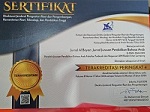The Student’s Understanding and Response Towards Case Study Method in Arabic Language Research l Istijabatu wa Mafhum al-Thalabah fi Manhaj Dirasah al-Halah fi Bahts al-Lughah al-‘Arabiyyah
Abstract
Keywords
Full Text:
PDFReferences
Adelman, Clem, David Jenkins, and Stephen Kemmis. “Re‐Thinking Case Study: Notes from the Second Cambridge Conference.” Cambridge Journal of Education 6, no. 3 (September 2007): 139–50. https://doi.org/10.1080/0305764760060306.
Ainin, Moh. “Efektifitas Penggunaan Pendekatan Pembelajaran Berbasis Masalah (Problem Based Learning) dalam Pembelajaran Matakuliah Metodologi Penelitian Bahasa Arab.” Bahasa dan Seni: Jurnal Bahasa, Sastra, Seni dan Pengajarannya 45, no. 2 (August 1, 2017): 197–207. https://doi.org/10.17977/um015v45i22017p197.
Andersson, Åsa, Peter Korp, and Anne B. Reinertsen. “Thinking With New Materialism in Qualitative Case Studies.” International Journal of Qualitative Methods 19 (January 1, 2020): 160940692097643. https://doi.org/10.1177/1609406920976437.
Bakker, Carien, Kees de Glopper, and Siebrich de Vries. “Noticing as Reasoning in Lesson Study Teams in Initial Teacher Education.” Teaching and Teacher Education 113 (May 2022): 103656. https://doi.org/10.1016/j.tate.2022.103656.
Barbieri, Giacomo, David Sanchez-Londoño, Laura Cattaneo, Luca Fumagalli, and David Romero. “A Case Study for Problem-Based Learning Education in Fault Diagnosis Assessment.” IFAC-Papers Online 53, no. 3 (2020): 107–12. https://doi.org/10.1016/j.ifacol.2020.11.017.
Basri, Syamsuriana, Reski Idamayanti, and Yusdarina Yusdarina. “Analisis Respon Mahasiswa terhadap Pembelajaran Daring Menggunakan Media Pembelajaran Google Classroom.” Jurnal Pendidikan Fisika 9, no. 2 (September 27, 2021): 172. https://doi.org/10.24127/jpf.v9i2.3994.
Ceylan, Sevil, and Zehra Ozdilek. “Improving a Sample Lesson Plan for Secondary Science Courses within the STEM Education.” Procedia - Social and Behavioral Sciences 177 (April 2015): 223–28. https://doi.org/10.1016/j.sbspro.2015.02.395.
Colorafi, Karen Jiggins, and Bronwynne Evans. “Qualitative Descriptive Methods in Health Science Research.” HERD: Health Environments Research & Design Journal 9, no. 4 (July 2016): 16–25. https://doi.org/10.1177/1937586715614171.
Creswell, John W. Research Design:Qualitative, Quantitative, and Mixed Method Approaches. 4th ed. Thousand Oaks: SAGE Publications, 2014.
Creswell, John W., and Cheryl N. Poth. Qualitative Inquiry & Research Design: Choosing Among Five Approaches. Fourth edition. Los Angeles: SAGE, 2018.
Doyle, Louise, Catherine McCabe, Brian Keogh, Annemarie Brady, and Margaret McCann. “An Overview of the Qualitative Descriptive Design within Nursing Research.” Journal of Research in Nursing 25, no. 5 (August 2020): 443–55. https://doi.org/10.1177/1744987119880234.
Ebneyamini, Shiva, and Mohammad Reza Sadeghi Moghadam. “Toward Developing a Framework for Conducting Case Study Research.” International Journal of Qualitative Methods 17, no. 1 (December 1, 2018): 160940691881795. https://doi.org/10.1177/1609406918817954.
Endraswara, Suwardi. Metodologi Penelitian Kebudayaan. Yogyakarta: Gajah Mada University Press, 2017.
Ernawati, Euis. “Perencanaan Pembelajaran Bahasa Arab di Perguruan Tinggi Pariwisata.” Arabiyat : Jurnal Pendidikan Bahasa Arab dan Kebahasaaraban 5, no. 1 (June 3, 2018): 15–37. https://doi.org/10.15408/a.v5i1.7515.
Fetterman, David M. “Qualitative Approaches to Evaluating Education”. Educational Researcher.” Educational Researcher 17, no. 8 (1988): 17–23.
Fuster Guillen, Doris Elida. “Investigación Cualitativa: Método Fenomenológico Hermenéutico.” Propósitos y Representaciones 7, no. 1 (January 1, 2019): 201. https://doi.org/10.20511/pyr2019.v7n1.267.
Gay, L. R., Geoffrey E. Mills, and Peter W. Airasian. Educational Research: Competencies for Analysis and Applications. 10th ed. Boston: Pearson, 2012.
Hancock, Dawson R, Bob Algozzine, and Jae Hoon Lim. Doing Case Study Research: A Practical Guide for Beginning Researchers. 4th ed. New York: Teachers College Press, 2021.
Iqbal, Md. Hafiz, Shamsun Akhter Siddiqie, and Md. Abdul Mazid. “Rethinking Theories of Lesson Plan for Effective Teaching and Learning.” Social Sciences & Humanities Open 4, no. 1 (2021): 100172. https://doi.org/10.1016/j.ssaho.2021.100172.
Janjai, S. “Improvement of the Ability of the Students in an Education Program to Design the Lesson Plans by Using an Instruction Model Based on the Theories of Constructivism and Metacognition.” Procedia Engineering 32 (2012): 1163–68. https://doi.org/10.1016/j.proeng.2012.02.072.
Kusmarini, Yani. “Studi Kasus (John W. Creswell) oleh Yani Kusmarini.” UGM J. Edu UGM (1989): 1-12.
Lincoln, Yvonna S., and Egon G. Guba. Naturalistic Inquiry. Beverly Hills, Calif: Sage Publications, 1985.
Marpaung, Dewi Natalia, and Jesi Jecsen Pongkendek. “Respon Mahasiswa terhadap Pembelajaran Interaktif dengan Animasi 3D Melalui Powerpoint.” Journal of Educational Chemistry (JEC) 2, no. 2 (September 24, 2020): 97. https://doi.org/10.21580/jec.2020.2.2.6401.
Martínez-Borreguero, Guadalupe, Francisco Luis Naranjo-Correa, Florentina Cañada Cañada, David González Gómez, and Jesús Sánchez Martín. “The Influence of Teaching Methodologies in the Assimilation of Density Concept in Primary Teacher Trainees.” Heliyon 4, no. 11 (November 2018): e00963. https://doi.org/10.1016/j.heliyon.2018.e00963.
Maxwell, Joseph. “Understanding and Validity in Qualitative Research.” Harvard Educational Review 62, no. 3 (September 1, 1992): 279–301. https://doi.org/10.17763/haer.62.3.8323320856251826.
Meleong, Lexy J. Metodologi Penelitian Kualitatif. Bandung: PT Remaja Rosdakarya, 2017.
Miles, Mathew B, A. Michael Huberman, Tjetjep Rohendi Rohidi, and Mulyarto Mulyarto. Analisis Data Kualitatif : Buku Sumber Tentang Metode-Metode Baru. Jakarta: UI Press, 1992.
Miles, Matthew B., A. M. Huberman, and Johnny Saldaña. Qualitative Data Analysis: A Methods Sourcebook. Fourth edition. Los Angeles: SAGE, 2020.
Muhammad, Darsa, and Muassomah Muassomah. “Respon Siswa Terhadap Pembelajaran Tarkib Berbasis Mind Mapping di Masa Pandemi Covid-19.” An Nabighoh: Jurnal Pendidikan dan Pembelajaran Bahasa Arab 23, no. 1 (June 25, 2021): 67. https://doi.org/10.32332/an-nabighoh.v23i1.3004.
Nasution, Saddat. Metode Penelitian Naturalistik Kualitatif. Bandung: Tarsito, 2003.
Nasution, Sahkholid, and Zulheddi Zulheddi. “Pengembangan Model Pembelajaran Bahasa Arab Berbasis Teori Konstruktivisme di Perguruan Tinggi.” Arabi : Journal of Arabic Studies 3, no. 2 (December 31, 2018): 121. https://doi.org/10.24865/ajas.v3i2.96.
Ndihokubwayo, Kizito, Céline Byukusenge, Edwin Byusa, Hashituky Telesphore Habiyaremye, Agnes Mbonyiryivuze, and Josiane Mukagihana. “Lesson Plan Analysis Protocol (LPAP): A Useful Tool for Researchers and Educational Evaluators.” Heliyon 8, no. 1 (January 2022): e08730. https://doi.org/10.1016/j.heliyon.2022.e08730.
Nilholm, Claes, Daniel Sundberg, Eva Forsberg, Åsa Hirsh, and Henrik Román. “The Aims and Meaning of Teaching as Reflected in High-Impact Reviews of Teaching Research.” Teaching and Teacher Education 107 (November 2021): 103488. https://doi.org/10.1016/j.tate.2021.103488.
Noor, Khairul Baharein Moh. “Case Study: A Strategic Research Methodology.” American Journal of Applied Sciences 5, no. 11 (November 1, 2008): 1602–4. https://doi.org/10.3844/ajassp.2008.1602.1604.
Nurahma, Gilang Asri, and Wiwin Hendriani. “Tinjauan Sistematis Studi Kasus dalam Penelitian Kualitatif.” Mediapsi 7, no. 2 (December 1, 2021): 119–29. https://doi.org/10.21776/ub.mps.2021.007.02.4.
Pranita, Uci, Nina Kurniah, and Anni Suprapti. “Pelaksanaan Supervisi Klinis Kepala Sekolah Pendidikan Anak Usia Dini Islam Terpadu Kota Bengkulu (Studi Deskriptif Kualitatif Di PAUD IT Auladuna Kota Bengkulu).” Jurnal Ilmiah Potensia 3, no. 1 (January 19, 2019): 54–65. https://doi.org/10.33369/jip.3.1.54-65.
Rahman, Taufik, Moh Hasan Basri, Hendra Mashuri, and Dyas Andry Prasetyo. “Respon Mahasiswa terhadap Perkuliahan Online Student’s Response to Online Lectures” 10, no. 2 (2021): 14.
Ridlo, Ubaid, Ahmad Royani, and Kisno Umbar. “Studi Kasus sebagai Metode Riset dalam Pembelajaran Bahasa Arab: Studi Tesis Magister Pendidikan Bahasa Arab di PTKIN.” Puslitpen UIN Syarif Hidayatullah Jakarta (2021): 4.
Rule, Peter, and Vaughn Mitchell John. “A Necessary Dialogue: Theory in Case Study Research.” International Journal of Qualitative Methods 14, no. 4 (November 20, 2015): 160940691561157. https://doi.org/10.1177/1609406915611575.
Rus, Dana. “Creative Methodologies in Teaching English for Engineering Students.” Procedia Manufacturing 46 (2020): 337–43. https://doi.org/10.1016/j.promfg.2020.03.049.
Sili, Kamal D. “Manhajiyah al-Bahts al-Ilmi.” Mansyurat Kulliyah al-Iqtishad Jamiáh Hama, 2016.
Sonday, Amshuda, Elelwani Ramugondo, and Harsha Kathard. “Case Study and Narrative Inquiry as Merged Methodologies: A Critical Narrative Perspective.” International Journal of Qualitative Methods 19 (January 1, 2020): 160940692093788. https://doi.org/10.1177/1609406920937880.
Stenberg, Katariina, and Katriina Maaranen. “Promoting Practical Wisdom in Teacher Education: A Qualitative Descriptive Study.” European Journal of Teacher Education (December 15, 2020): 1–17. https://doi.org/10.1080/02619768.2020.1860012.
Sudjana, Nana, and Ibrahim. Penelitian dan Penilaian Pendidikan. Bandung: Sinar Baru Algesindo, 2016.
Sugiyono, Sugiyono. Memahami Penelitian Kualitatif: Dilengkapi Contoh Proposal dan Laporan Penelitian. Bandung: Alfabeta, 2016.
———. Metode Penelitian Evaluasi (Pendekatan Kuantitatif, Kualitatif, dan Kombinasi). Bandung: Alfabeta, 2018.
———. Metode Penelitian Kombinasi (Mixed Methods). Bandung: Alfabeta, 2017.
———. Metode Penelitian Kualitatif (Untuk Penelitian Yang Bersifat: Eksploratif, Enterpretif, Interaktif Dan Konstruktif). Bandung: Alfabeta, 2017.
———. Metode Penelitian Kuantitatif. Bandung: Alfabeta, 2019.
———. Metode Penelitian Pendidikan (Kuantitatif, Kualitatif, Kombinasi, R&D Dan Penelitian Pendidikan). Bandung: Alfabeta, 2019.
———. Metode Penelitian Pendidikan: (Pendekatan Kuantitatif, Kualitatif dan R & D). Bandung: Alfabeta, 2019.
Sukmadinata, Nana Syaodih. Metode Penelitian Pendidikan. Bandung: Program Pascasarjana UPI dengan PT Remaja Rosdakarya, 2005.
Sulaikho, Siti, and Lailatul Mathoriyah. “Respon Mahasiswa Terhadap Buku Ajar Morfologi Bahasa Arab Berbasis Analisis Kontrastif.” DINAMIKA : Jurnal Kajian Pendidikan dan Keislaman 4, no. 2 (December 31, 2019): 51–64. https://doi.org/10.32764/dinamika.v4i2.784.
Thamrin, Husni, and Endang Wahyu Pamungkas. “A Rule Based SWOT Analysis Application: A Case Study for Indonesian Higher Education Institution.” Procedia Computer Science 116 (2017): 144–50. https://doi.org/10.1016/j.procs.2017.10.056.
Tomaszewski, Lesley Eleanor, Jill Zarestky, and Elsa Gonzalez. “Planning Qualitative Research: Design and Decision Making for New Researchers.” International Journal of Qualitative Methods 19 (January 1, 2020): 160940692096717. https://doi.org/10.1177/1609406920967174.
Wijaya, Caroline Vinci, and Sinta Paramita. “Komunikasi Virtual dalam Game Online (Studi Kasus dalam Game Mobile Legends).” Koneksi 3, no. 1 (December 6, 2019): 261. https://doi.org/10.24912/kn.v3i1.6222.
Wiksana, Wiki Angga. “Studi Deskriptif Kualitatif tentang Hambatan Komunikasi Fotografer dan Model dalam Proses Pemotretan.” Mediator: Jurnal Komunikasi 10, no. 1 (June 1, 2017): 121–31. https://doi.org/10.29313/mediator.v10i1.2661.
Wiraatmadja, Rochiati. Metode Penelitian Tindakan Kelas. Bandung: Remaja Rosdakarya, 2007.
Yin, Robert K. "Case study research design and methods third edition." Applied Social Research Methods Series 5 (2003).
Zedan, Ashraf M., Fakhrul Adabi Bin Abdul Kadir, Mouhammed Bin Yusof, Yusmini Binti Md Yusoff, Norrodzoh Binti Hj Siren, Roslan Bin Mohamed, and Sekou Toure. “The Role of Language in Education: Arabic as Case Study.” Procedia - Social and Behavioral Sciences 70 (January 2013): 1002–8. https://doi.org/10.1016/j.sbspro.2013.01.151.
Zedan, Ashraf M., Mohd Yakub Zulkifli Bin Mohd Yusoff, and Mr. Roslan Bin Mohamed. “An Innovative Teaching Method in Islamic Studies: The Use of PowerPoint in University of Malaya as Case Study.” Procedia - Social and Behavioral Sciences 182 (May 2015): 543–49. https://doi.org/10.1016/j.sbspro.2015.04.776.
Zubaidi, Ahmad. “Model-Model Pengembangan Kurikulum dan Silabus Pembelajaran Bahasa Arab.” Cendekia: Jurnal Kependidikan dan Kemasyarakatan 13, no. 1 (November 27, 2015): 107. https://doi.org/10.21154/cendekia.v13i1.240.
Zulkhairi, Zulkhairi, Arneliwati Arneliwati, and Sofiana Nurchayati. “Studi Deskriptif Kualitatif: Persepsi Remaja terhadap Perilaku Menyimpang.” Jurnal Ners Indonesia 9, no. 1 (July 19, 2019): 145. https://doi.org/10.31258/jni.8.2.145-157.
DOI: http://dx.doi.org/10.24042/albayan.v14i1.10607
Refbacks
- There are currently no refbacks.
Copyright (c) 2022 Jurnal Al Bayan: Jurnal Jurusan Pendidikan Bahasa Arab
License URL: https://creativecommons.org/licenses/by-sa/4.0
Editorial Office:
Jurnal Al Bayan: Jurnal Jurusan Pendidikan Bahasa Arab, Arabic Education Study Program, Faculty of Education and Teachers Training, Unversitas Islam Negeri Raden Intan Lampung
Jl. Endro Suratmin 1 Sukarame, Bandar Lampung 35131-Indonesia
e-mail: jurnalalbayan@radenintan.ac.id
http://ejournal.radenintan.ac.id/index.php/albayan/index
Jurnal Al Bayan: Jurnal Jurusan Pendidikan Bahasa Arab is licensed under a Creative Commons Attribution-ShareAlike 4.0 International License. p-ISSN 2086-9282 | e-ISSN 2549-1229









